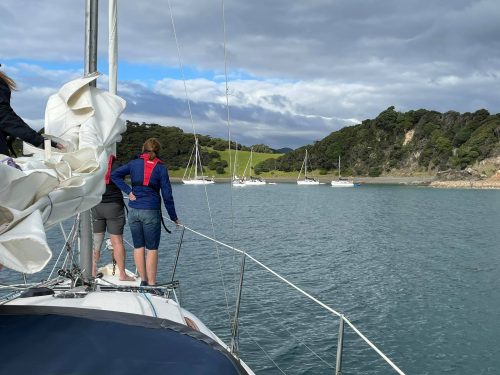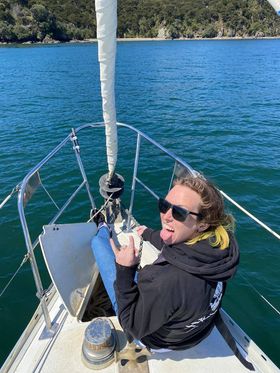Ahoy there, sailors and seafarers! Whilst a couple of our salty mates enjoy the spectacle of a chorus of voices at full blast you don’t want to be the ones providing the entertainment at anchoring time. It can be tempting to crank up the volume on your vocal cords to make sure the crew and helmsperson know what’s going on but with a silent symphony of hand signals in quiet coordination you can create a masterclass maritime ballet.
 Roles when anchoring
Roles when anchoring
Let’s talk signals, shall we? We won’t pretend these are cast-in-stone edicts; your crew’s agreement and practice are your compass here. But hey, once you’ve squared away your anchoring spot or mooring, the conductor on the foredeck takes center stage. The helmsman? Well, they’re the virtuoso following the signals, not mere “suggestions.” Both hands on deck need a knack for how your vessel dances through the water at neutral in various conditions. And don’t forget what your trusty engine can muster in terms of momentum when it tangos with gears at low speeds.
Signals to use
Now, in this nautical semaphore, some signals are a no-brainer. They’re like stars in the daytime sky—clear and unforgettable. We’ve snatched a few from the pros: tactical squads, heavy-machinery magicians, and the like. Picture this: an arm raised high, fist clenched in the air. In regular-speak, that’s a “Freeze!” or “Hold it.” But for us, it’s more like “Shift to neutral, steady that helm, and await my next cue.” Mind you, it’s not the same as “Stop,” which often involves a palm facing backward, potentially mistaken for “Reverse and halt!” We’re not fans of “Stop” anyway; when you’re crawling at snail’s pace for anchoring or mooring, forward, reverse, and neutral are your shanty.
For “Full steam ahead,” a hand held steady with a finger pointing skyward is your friend. When it’s time to backpedal, finger down is the call. And that clenched fist? That’s our neutral stance. Sure, you could go with simple waves to signal the engine’s fate, but there’s a certain flair in the elegance of a stationary hand. As long as silence reigns supreme, it’s all smooth sailing.
Navigating direction spices things up a tad. Employ your other hand to point or use the hand that isn’t commandeering the throttle for speed shifts. Either way, hoist your signaling arm above shoulder level, keeping those peepers on the helm view. Aim your pointing finger at the aqua realm your helmsman ought to navigate. Generally, that means pointing to the target anchoring spot or mooring. Yet, remember, on some crafts, it translates to “This way, sailor!” regardless of the endpoint. Clear that up with your crew, or just enjoy the entertainment if wires cross.
Those are the basics, shipmates. You can jazz things up or add more signals as you please—like signaling “zoom” (jab upward a couple of times) or “easy does it” (jab downward), sharing the news that the anchor’s sunk or surfaced, disclosing water depth, and such. But remember, it’s easy to drown the basics in a sea of complexity.
 Plan ahead
Plan ahead
Prep work pays off, mateys. Take a tour around the anchorage before the grand maneuver, gather your crew’s thoughts. Wind or current: who’s the mightier opponent? That’ll decide your approach. Steer right into the formidable force. And make sure that anchor is ready for its big dive, plenty of rode on display. If mooring’s your gig, have that boathook ready to lasso your goal—or play pointer.
One more tidbit: devise a silent cue to whisper to the helmsman when the grand plan falls flat. Missed that mooring ball, did we? Or is the anchor sliding across the sand? This signal’s the Dosey Doe “Let’s redo this dance, gather the troops, and give it another whirl.” It’s not a problem to go around again, just be cool and stay calm.
Dance to the sea’s tune
So, there you have it, swashbucklers. Master these signals, dance to the sea’s tune, and let your ship sail as a harmonious orchestra of silent cues. The sea’s your stage, and you’re the stars of this Great Escape Sailing symphony.
If you want to know more about anchoring Click here for to read our earlier post on anchoring successfully .
(Thanks to the team at Practical Sailor who inspired this post).





